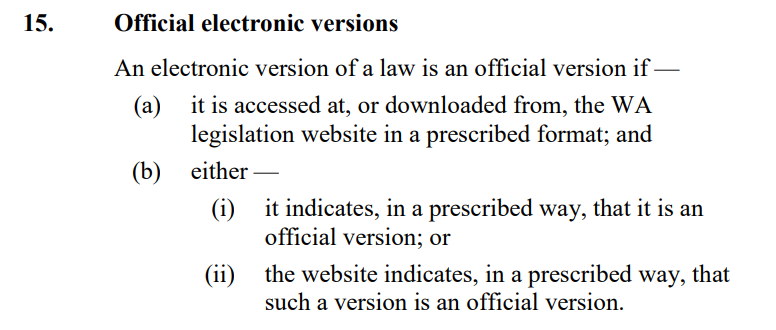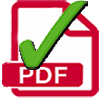Frequently Asked Questions (FAQ)
| Q1. | How up to date is the information on this website ? | top |
|---|---|---|
| A. | New Acts are generally added to the website on the working day following Royal Assent. For new subsidiary legislation made in Executive Council, PCO generally publishes the instruments on this website on the day following receipt of signed copies of the instruments from the Executive Council. For new subsidiary legislation made by a Minister or other person or body, PCO generally publishes the instruments on this website on the day following receipt of signed copies of the instruments from the relevant agency. Changes to legislation in the Acts in force and Subsidiary legislation in force collections are consolidated within 2 working days of the amending provision/s commencing. The Acts ceased and Subsidiary legislation ceased collections are updated within 2 working days of the repeal or expiry of an Act or subsidiary legislation or it ceasing to be in force. | |
| Q2. | What does “Currency” mean ? | top |
| A. | Currency dates for individual legislation can be found by clicking on the selected title to view current and previous versions (if any). Currency start dateThe currency start date is the date that the legislation first came into effect in that form. This may be the commencement date of the legislation or a substantive amendment, the as at date of a reprint or when editorial powers are exercised under the Legislation Act 2021 Part 3. However, in some cases it may be the date that administrative information (e.g. information about provisions that have not come into operation) is inserted in the notes at the end of the legislation. Currency end dateThe currency end date is the date that the legislation ceased to be in effect in that form. This may be because the legislation was amended or reprinted, editorial powers were exercised under the Legislation Act 2021 Part 3 or the legislation was updated with administrative information (e.g. information about provisions that have not come into operation) or repealed. | |
| Q3. | How do I find out what changes have been made between different versions of legislation ? | top |
| A. | This website provides a document compare function. The compare documents on this website are a comparison between a version of legislation at a particular point in time (the “currency start” date) and the previous version of that legislation. The compare document is designed to highlight changes made to the legislation by amending legislation. It also shows editorial changes made under the Reprints Act 1984 or Legislation Act 2021 Part 3. For further details please see document compare. | |
| Q4. | Who incorporates legislative amendments into the legislation on the website ? | top |
| A. | Parliamentary Counsel’s Office incorporates amendments in the legislation on this website. | |
| Q5. | What is the status of legislation on this website? Is it official? | top |
| A. | This website contains official and unofficial versions of WA legislation. Official versions of legislation have legal status, and are presumed to correctly set out the text of the legislation. The Legislation Act 2021 section 17 gives that status to official versions of legislation as originally passed or made, and official versions of legislation with amendments incorporated. An official version is also evidence that any editorial changes made under Part 3 of the Act are authorised. Official electronic versions The Legislation Act 2021 section 15 provides as follows:  FAQ6 explains how to identify an official electronic version of legislation on this website. Official hard copy versions The Legislation Act 2021 section 16 provides as follows:  The Legislation Regulations 2021 regulation 8 sets out how to identify an official hard copy version of an Act or subsidiary legislation in cases where it is not produced directly from an official version on this website. This is relevant, for example, for copies of WA legislation published before 1 July 2023. | |
| Q6. | How can I tell if a document is an official version of the law ? | top |
| A. | This website indicates that a law is official by way of a tick symbol An electronic version of an Act or subsidiary legislation published on or after 1 July 2023 also indicates that it is an official version by the coat of arms of the State appearing on the first page and the words “Official Version” appearing in the footer on each page. Earlier versions on this website do not include those indications but are official because they are available in PDF format and the PDF icon link to them contains the tick symbol. | |
| Q7. | In what formats are the documents made available ? | top |
| A. | Word, PDF and HTML | |
| Q8. | What are editorial changes and how can I tell if any have been made ? | top |
| A. | The Legislation Act 2021 Part 3 authorises the Parliamentary Counsel to make editorial changes to keep laws up-to-date with contemporary drafting practice, simplify laws, and correct errors. This power to make editorial changes cannot, however, be used to change the effect of a law. The Legislation Act 2021 section 17(3) provides that an official version of legislation is evidence that any editorial changes made under Part 3 of the Act are authorised. The Legislation Act 2021 section 40 provides that an editorial change made to a law is treated in the same way as an amendment. It has the same effect as if the law had been amended by another law commencing on the day on which the change is made. Editorial changes are noted in the Compilation table and the Editorial changes table. The Compilation table notes the creation of a new version of a law that contains editorial changes, while the Editorial changes table notes the provisions that have been editorially changed. To see the editorial changes included in a version of a law, see the compare document for that version on this website. | |
| Q9. | How do I find out which Minister/Agency is responsible for an Act or regulations, rules, etc. ? | top |
| A. | Responsibility for the administration of Acts (and in some cases particular parts of Acts) is determined from time to time by the Governor under the Interpretation Act 1984 section 12. The Administration of Departments, Authorities, Statutes and Votes is published periodically in the WA Government Gazette, and changes from time to time. The information is available on this website under the heading Acts with administering portfolios and public sector agencies. This information is updated frequently and sets out the Ministers who are responsible for the administration of particular Acts (or parts of them) and the relevant public sector agency. This information is also displayed under the Act title in the Acts collection (the “Act home page”). | |
| Q10. | How do I find out if an Act or regulations, rules, etc. has been amended ? | top |
| A. | You can obtain this information in 2 ways:
| |
| Q11. | How do I find out when an Act commences ? | top |
| A. | Most Acts contain a commencement provision (usually section 2). If there is no commencement provision, the Act commences on the 28th day after the date it receives the Royal Assent (see the Interpretation Act 1984 section 20). At the end of the document, in the notes section, there are details of commencement. The most common commencement times are:
Alternatively, you can view the Legislation Information Assent, commencement and ceasing information for Acts which shows the assent, commencement and ceasing information for all Acts passed. | |
| Q12. | How do I find out what Acts are in force ? | top |
| A. | By viewing the Legislation Information Acts in force. However you may need to obtain legal advice about whether an Act still applies. | |
| Q13. | How do I find out what regulations, rules, etc. are in force ? | top |
| A. | By viewing the Legislation Information Subsidiary legislation in force. This information is arranged by principal Acts under which subsidiary legislation and other instruments have been made, sorted alphabetically by title. Each entry gives repeal or expiry information. | |
| Q14. | How do I find out when an Act is going to be proclaimed ? | top |
| A. | For information concerning the anticipated proclamation of an Act, you should contact the Government department or public sector agency responsible for the Act. PCO cannot provide that information. | |
| Q15. | How do I obtain a copy of a proclamation ? | top |
| A. | Before 1 July 2023, proclamations of Acts were published in the Gazette, available on this website. From 1 July 2023, proclamations of Acts are published on this website. | |
| Q16. | What does the information in the footers of consolidated versions of legislation mean ? | top |
| A. | Each footer contains:
| |
| Q17. | What is a Reprint ? | top |
| A. | A reprint of legislation is an authorised consolidation of legislation printed by the Government Printer under the authority of the Reprints Act 1984. It incorporates all amendments in operation at the date shown on the reprint. Any amending provisions not yet in force appear in the notes at the end of the reprint. On 1 July 2023, the Reprints Act 1984 is repealed by the Legislation Act 2021 s. 45. The collection of reprints on this website continues to have official status. Reprints are no longer necessary because official status is given to versions of legislation on this website that incorporate amendments. See FAQ5. | |
| Q18. | How do I find out if a Bill has been introduced into Parliament ? | top |
| A. | For all information regarding Bills, see the Parliament of Western Australia website www.parliament.wa.gov.au. | |
| Q19. | How can I be notified of new legislation and changes to existing legislation ? | top |
| A. | RSS feeds can be configured from pages where you see this symbol RSS Feeds of new Government Gazettes can also be configured from this page. | |
| Q20. | What is the SL number that appears on subsidiary legislation ? | top |
| A. | The SL number is a unique identifier assigned to subsidiary legislation published on this website, and appears in the format “SL 2023/1”. Where an instrument needs to be referenced in WA legislation other than by its title, it is referenced using this unique identifier. | |
| Q21. | What is the suffix for ? | top |
| A. | This is an identifier used for internal PCO purposes and appears in the footer of legislation. Example: 02 — d0 — 00 | |
| Q22. | A number of instruments called Laws are published in the Acts in force collection. What are they ? | top |
| A. | A number of Laws are included in the Acts in force collection as if they were Acts. Examples include the Australian Consumer Law (WA), the Legal Profession Uniform Law (WA) and the Rail Safety National Law (WA). They have no Act No. A number of WA Acts provide that the law of another jurisdiction (either the Commonwealth or a State) applies as a law of Western Australia. This kind of legislation is called a “national uniform law” or an “applied law scheme”. It is typically used when what is wanted is a law that applies consistently across Australia. A law is enacted by the Commonwealth or a State, and other States apply the law as a law of their own jurisdiction (an applied law). Examples of WA Acts (application Acts) that apply the law of another jurisdiction as a law of WA include the following:
The application Acts are included in the Acts in force collection. In addition, versions of some applied laws are included as separate instruments in that collection and called Laws rather than Acts. These versions of applied laws are updated when the applied laws are amended for WA under the mechanism adopted in the application Acts to enable parliamentary scrutiny of amendments to the applied laws before the amendments take effect. For an example of that mechanism, see the Rail Safety National Law Application Act 2024 sections 7 to 9. If subsidiary legislation made under an applied law is applied in WA, versions of the subsidiary legislation are also generally published on the WA legislation website. Note that an application Act usually excludes the application to the applied law of a number of WA Acts (such as the Interpretation Act 1984), and the application Act or the applied law provides that 1 or more Acts of another jurisdiction apply instead. An example is the Rail Safety National Law Application Act 2024 section 20 and the Rail Safety National Law (WA) section 5. | |
| Q23. | Where can I view COVID-19 directions ? | top |
| A. | An historical collection of COVID-19 directions made under the Emergency Management Act 2005 and the Public Health Act 2016 is available on this website. To view the COVID-19 directions made under the: The COVID-19 directions no longer apply. |


 on the PDF icon link for accessing or downloading the law.
on the PDF icon link for accessing or downloading the law. ,
,  or from our
or from our